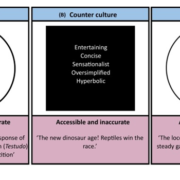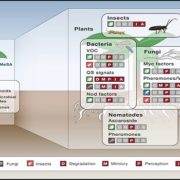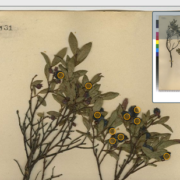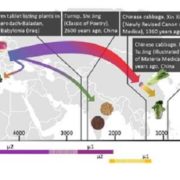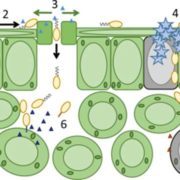Letter to the editor: Planting equity: Using what we know to cultivate growth as a plant biology community
This letter by Beronda Montgomery is the 1st in our series on diversity, equity, and inclusion in STEM disciplines. Read the editorial call for letters here: Sowing the seeds of equity and diversity in academia and STEM disciplines.
Montgomery, BL (2020). Planting equity: Using what we know to cultivate growth as a plant biology community. Plant Cell 32: 3372-3375 doi: 10.1105/tpc.20.00589
Our nation, and indeed our world, is dealing with the challenges of the global COVID-19 pandemic. In the midst of this, two recent events occurred with Black men that have reverberated globally, including throughout scientific spaces. An event in New York’s Central Park during which a white woman weaponized calling the police on Black birder Christian Cooper and falsely accused him of threatening her life stimulated many Black scientists to organize Black in STEM (science, technology, engineering, and mathematics) weeks, including #BlackBotanistsWeek, that focused on a range of disciplines and issues of Black scientists (Mallenbaum, 2020). The same day as the Cooper incident, another Black man was killed at the hands of police in the United States. I state “another” in no way to downplay the importance of George Floyd’s life and senseless killing, but to emphasize that this recent tragedy is one in a long, disastrous thread of such incidences (Blain, 2020). Yet, there has been apparent widespread awareness and indignation with Floyd’s death that led to national, and indeed global, protests against police brutality and anti-Black bias, as well as seeming commitment to reckon with the terrible impact of racism. In academia, many, in and outside of the plant biology community, participated in #ShutDownSTEM and #ShutDownAcademia on June 10, 2020, which encouraged “White and Non-Black People of Color (NBPOC) to not only educate themselves, but to define a detailed plan of action to carry forward” (https://www.shutdownstem.com/; Subbaraman, 2020). The American Society of Plant Biologists (ASPB) also participated in this movement: the ASPB leadership produced a statement that voiced support for the efforts and a call for and commitment to ongoing reflection and plans for change (Callis et al., 2020). Here, I reflect on ways we might use our knowledge as plant scientists to help us address systemic racism and persistent issues of inequity in scientific spaces and far beyond.
We all acknowledge that our lives and our research laboratories have been affected by the global health crisis triggered by the novel SARS-CoV-2 virus that causes COVID-19. We have experienced this at multiple levels. First, many of us faced a rapid ramp down of research activities (all research not directly related to SARS-CoV-2) in mid-March 2020 after the virus started to become more prevalent in the United States (Servick et al., 2020). Additionally, we are now involved in crafting and enacting “return-to-work” plans for reopening or ramping up efforts in laboratories that has us conducting research in new ways, altered formats, and at a modified pace and perhaps scope (Montgomery, 2020). It is important to note that the emergence of SARS-CoV-2 and our long national history of racism, the latter brought to the forefront of our collective awareness with the murder of George Floyd (for some, brought forth yet again, and for others, as a new appreciation of the depths of the impact of this history in our country), are not separate issues. COVID-19 is disproportionately plaguing communities of color, linked to recognized health and economic disparities and other factors in the United States (Godoy and Wood, 2020). Thus, while Black students, staff, and faculty are grappling with the latest atrocities related to racism, these same individuals are much more likely to have been personally touched by the current global health pandemic. Yet, there is a striking difference between the ways in which institutions and organizations have responded to these interrelated crises: there has been a rapid response to shifting instructional methods, student engagement, and staff and faculty support to online engagement related to COVID-19 and its effect on institutions but slower and often uncertain responses to issues related to anti-Black racism (Montgomery, 2020).
However, in the wake of these recent and very visible anti-Black racism incidents and the conversations they have initiated, many organizations and universities have begun to reflect upon the path forward. Many of the activities that have been shared include the issuing of statements of solidarity, or commitments to engage with literature and experts who study racism and anti-racist practices, which are both meaningful and valuable (Montgomery, 2020). During this time, I have personally continued to reflect on the many ways that we often overlook knowledge near and dear to us in helping us navigate specific moments such as the one we are facing—an urgent need to address systemic racism and to actively promote equity in and outside of scientific spaces. Disciplinary societies have critical and active roles to play in addressing racism in STEM fields and engaging members in difficult conversations and promoting culturally aware practices among scientists in the community (Montgomery, 2016; Montgomery and Colón-Carmona, 2016). As I have described previously, “recent national conversations regarding race relationships and interactions across diverse demographic groups do not stop at the doors of our laboratories, institutions or disciplinary societies, because science, education and research do not occur in vacuums” (Montgomery, 2016).
The statement issued by the leaders of ASPB in response to these recent events declares that “a diverse community is stronger, smarter, and more resilient” (Callis et al., 2020). As plant biologists, we know this to be true for many plant communities as well. For example, biodiversity is positively linked to stability and resistance to environmental disruptions such as climate events in natural and managed ecosystems (Tilman et al., 2014; Isbell et al., 2015) and to improved plant productivity in polyculture for many plant species (Adetiloye, 2004; Li et al., 2007, 2014; Wang et al., 2014). Thus, we need to consider that diversity enhances the success of communities, whether we speak of species and functions within an ecosystem of plant communities or social categories in human communities (e.g., race, ethnicity, national origin, gender, sexual orientation, disability, religion, to name a few). Although we have much work ahead of us to ensure proportionate participation of demographically diverse individuals in STEM, including in plant biology, even more attention and effort is needed for equitable engagement. This focus on equity calls for a need to guarantee that the innovations of demographically underrepresented scientists are not discounted, thereby adding to disparities in their entry into and advancement in STEM and academic spaces (Hofstra et al., 2020). Social justice practices and an active pursuit of equity can ensure that the full range of perspectives of the diverse individuals represented are actively incorporated in the successful functioning of a community beyond the pursuit of structural diversity or mere numerical representation (Hurtado et al., 1998; Rivera-McCutchen, 2014; National Academies of Science, Engineering, and Medicine, 2019).
Whether we speak of plants or humans, the health of individuals is affected both by the community in which they exist and by the external environment. Plant researchers routinely look at the phenotype of a plant and ask questions about how the phenotype arose in the context of a plant’s identity as influenced by the environment in which it exists. In assessing a plant phenotype in context, we acknowledge that the environmental conditions in which a seed germinated and a seedling emerged, developed, and grew contributed to the current state it is in. As we engage in the long-needed process of reflection, education, and action that was the focus of #ShutDownSTEM and #ShutDownAcademia, we might ask ourselves how we perceive the phenotypes, or outcomes, of people with whom we share an environment, especially those from racial and ethnic groups that are underrepresented or marginalized in STEM and higher education as a whole. Notably, the use of the term “underrepresented” itself has been recognized as having the potential to mask the nature of these groups not being historically structured into, or being actively excluded from, these spaces (Dodson et al., 2009; Williams, 2020). We may attribute outcomes to our perception of a person’s “capabilities,” but could we ask similar and intentional questions that we ask about plants and their performance or outcomes in a particular environment? These plant-related inquiries generally include questions about the influence of environmental conditions that have shaped the phenotype or outcomes that we see before us and the importance of the care and tending of individuals in a particular context; indeed, it would be difficult to find a leading plant biology journal that does not require details of plant growth conditions for any investigation related to assessing outcomes, such as plant phenotypes and fitness. These questions are considered critical inquiries, as plant scientists are aware that selective pressures of particular cultivation conditions establish a narrow filter for fitness. Thus, we should not leave meaningful knowledge that we have gained about how environments affect the success and outcomes of individual plants and plant communities in our laboratory or field spaces solely to the texts of our manuscripts and plans for future experiments. We might ask whether and how this knowledge might be applied to our perceptions and actions with respect to our interpersonal relationships.

Signal Transduction at the Interface of Organisms and the Environment. (A) Deficit-based transduction is frequently used to assess individuals in academic contexts in which an outcome is generally perceived from which we then move to some type of judgment about an individual. Such deficit-based transduction fails to adequately consider, or can fail to include an assessment of, the influence of environmental factors and their effect on observed individual outcomes. (B) Summarized signal transduction pathway in plants, including perception of an environmental cue by a plant receptor, transduction or modulation of a plant signaling network, and phenotypic outcomes. (C) Cultivating stewardship-based transduction for supporting individuals involves using a parallel process to one that we know works effectively in supporting plant productivity in context. In this instance, the importance of environmental cues, their perception, either directly by individuals or facilitated by transfer of heuristic knowledge from mentors and leaders who serve as environmental stewards, can support the development and cultivation of networks that foster personal growth and professional development outcomes.
In our engagements with colleagues and students, we frequently default to deficit-based assessments and perspectives. That is, in instances where outcomes (an individual’s “phenotype”) diverge from expectations in terms of success, we may judge that the individual suffers from inherent weaknesses or personal deficits that can lead to the perception of them as not being a good “fit” in a particular learning or research environment (see figure, A). Our responses can be modulated by our biases about individuals from particular groups, backgrounds, or experiences such that we give up on them altogether, or in “well-meaning” cases offer them support or “mentoring” through assimilation-based lenses (i.e., the “one-way assimilate or fail model” described by Paris [2019]; see figure, A). Such deficit-based conclusions presume infallibility or optimal properties of a particular environment and assign the primary responsibility for observed outcomes to the individual under observation—their personal agency, resilience, or enacted personal strategies, or lack of any of these (Montgomery, 2018). However, it is important to recognize that these deficit-based conclusions, judgments of “poor fit,” and subjective definitions of “fit” have been identified as serving as a “covert channel of racial bias” (White-Lewis, 2020). That is, “fit” can often be used to discount or prevent the inclusion of specific individuals in a particular community based on perceived shortfalls in cultural capital or mis-fit in social exchanges, rather than critical assessments of technical or scientific preparation for their contributions to or engagement in a community.
We would be better served, even if only as a starting point for engaging growth-based perspectives (Montgomery, 2018), to approach our assessments and support of colleagues through a stewardship-based transduction model that, in effect, mirrors what we know about plants (see figure, B and C). Such framing would allow us to transfer what we as plant biologists know about plant fitness and success being significantly influenced by environmental conditions, and the ability of plants to perceive and respond to dynamic conditions, to interpersonal relationships within our communities. We know that plants respond as individuals but also exhibit powerful community dynamics and intra- and inter-community communication that contribute to the success of individuals and groups and to the stability and resilience of an ecosystem.
Our moving toward the needed change in the ways that we reflect upon, communicate about, and act thoughtfully, yet intentionally, toward building, cultivating, and sustaining an equitable community in plant biology and beyond will require significant effort, resources, and long-term commitment and leadership. It will require us to read, engage, and use knowledge and strategies beyond our disciplines. It will require us to shift from “gatekeeping” practices, in which we carefully guard the gates and make subjective, and often biased, decisions about who “fits” and is worthy to enter, to actively using “groundskeeping” practices, whereby we thoughtfully tend our environments to actively support access and progress, and recognize and remove barriers to individual success (Montgomery, 2020). In this process, we should not leave behind the knowledge that we have about the organisms many of us have spent or will spend a significant part of our lives studying as we seek knowledge that will propel the work of equity in plant biology. We will need multiple sources of knowledge and an openness to change and innovation to promote more expeditious progress: what we know about plants and what we can learn from deep reflection on that knowledge may serve key roles in our getting to where we say we want to be, where we desperately need to be—a place of planting and cultivating equity in our human relationships.
Department of Biochemistry and Molecular Biology, Department of Microbiology and Molecular Genetics, Michigan State University, East Lansing, Michigan 48824
For correspondence: [email protected]
REFERENCES
Adetiloye, P. O. (2004). Effect of plant populations on the productivity of plantain and cassava intercropping. Moor J. Ag. Res. 5: 26-32.
Blain, K. (2020). Violence in Minneapolis is rooted in the history of racist policing in America. Wash. Post. https://www.washingtonpost.com/outlook/2020/05/30/violence-minneapolis-is-rooted-history-racist-policing-america/
Callis, J., Last, R., McCann, M., and Taylor, C. (2020). Silence suffocates us all. Plant Sci. Today. https://shutdownstem.aspb.org/wp-content/uploads/2020/06/Silence-Suffocates-Us-All.pdf
Dodson, J. E., Montgomery, B. L., and Brown, J. L. (2009). “Take the Fifth”: Mentoring students whose cultural communities were not historically structured into U.S. higher education. Innovative Higher Education 34: 185-199.
Godoy, M. and Wood, D. (2020). What do coronavirus racial disparities look like state by state? NPR. https://www.npr.org/sections/health-shots/2020/05/30/865413079/what-do-coronavirus-racial-disparities-look-like-state-by-state.
Hofstra, B., Kulkarni, V. V., Galvez, S. M-N., He, B., Jurafsky, D., and McFarland, D. A. (2020). The diversity-innovation paradox in science. Proc. Natl. Acad. Sci. USA 117: 9284-9291.
Hurtado, S., Milem, J. F., Clayton-Pedersen, A. R., and Allen, W. R. (1998). Enhancing campus climates for racial/ethnic diversity: Educational policy and practice. Rev. Higher Ed. 21: 279-302.
Isbell, F., Craven, D., Connolly, J., et al. (2015). Biodiversity increases the resistance of ecosystem productivity to climate extremes. Nature 526: 574-577
Li, L., Li, S.-M., Sun, J.-H., Zhou, L.-L., Bao, X.-G., Zhang, H.-G., and Zhang, F.-S. (2007). Diversity enhances agricultural productivity via rhizosphere phosphorus facilitation on phosphorus-deficient soils. Proc. Natl. Acad. Sci. USA 104: 11192-11196.
Li, L., Tilman, D., Lambers, H. and Zhang, F.-S. (2014). Plant diversity and overyielding: Insights from belowground facilitation of intercropping in agriculture. New Phytol. 203: 63-69.
Mallenbaum, C. (2020). #BlackBirdersWeek, #BlackInNeuro: Black scientists, physicians are using hashtags to uplift. USA Today. https://www.usatoday.com/story/life/2020/08/04/blackinneuro-blackinchem-can-hashtags-help-black-scientists-build-community-spotlight-excellence/5541431002/
Montgomery, B.L. (2016). Cultivating a focus on diversity as a community. ASBMB Today 15: 42-43.
Montgomery, B. L. (2018). From deficits to possibilities: Mentoring lessons from plants. Public Philos. J. 1:10.25335/M5/PPJ.1.1-3
Montgomery, B. L. (2020). Academic leadership: Gatekeeping or groundskeeping? J. Values-Based Leadership 13: 135-151. https://scholar.valpo.edu/jvbl/vol13/iss2/16.
Montgomery, B. L. and Colόn-Carmona, A. (2016). Planting seeds for a reflective harvest: The role of ASPB in enhancing diversity in plant biology. ASPB News 43: 21-22.
National Academies of Sciences, Engineering, and Medicine (2019). The Science of Effective Mentorship in STEMM. Washington, DC: The National Academies Press. https://doi.org/10.17226/25568.
Paris, D. (2019). Naming beyond the white settler colonial gaze in educational research. Intl. J. Qual. Studies Educ. 32: 217-224.
Rivera-McCutchen, R. L. (2014). The moral imperative of social justice leadership: A critical component of effective practice. Urban Rev. 46: 747-763.
Servick, K., Cho, A., Guglielmi, G., Vogel, G., and Couzin-Frankel, J. (2020) Labs go quiet as researchers brace for long-term coronavirus disruptions. Science doi:10.1126/science.abb7259.
Subbaraman, N. (2020). Thousands of scientists worldwide to go on strike for Black lives. Nature doi: 10.1038/d41586-020-01721-x
Tilman, D., Isbell, F., and Cowles, J.M. (2014). Biodiversity and Ecosystem Functioning. Ann. Rev. Ecol. Evol. Syst. 45: 471-493.
Wang, Z.-G., Jin, X., Bao, X.-G., Li, X.-F., Zhao, J.-H., Sun, J.-H., Christie, P. and Li, L. (2014). Intercropping enhances productivity and maintains the most soil fertility properties relative to sole cropping. PLoS ONE 9: e113984.
White-Lewis, D. K. (2020). The facade of fit in faculty search processes. J. Higher Ed. doi: 10.1080/00221546.2020.1775058
Williams, T. L. (2020). ‘Underrepresented minority’ considered harmful, racist language. BLOG@CACM. https://cacm.acm.org/blogs/blog-cacm/245710-underrepresented-minority-considered-harmful-racist-language/fulltext.


